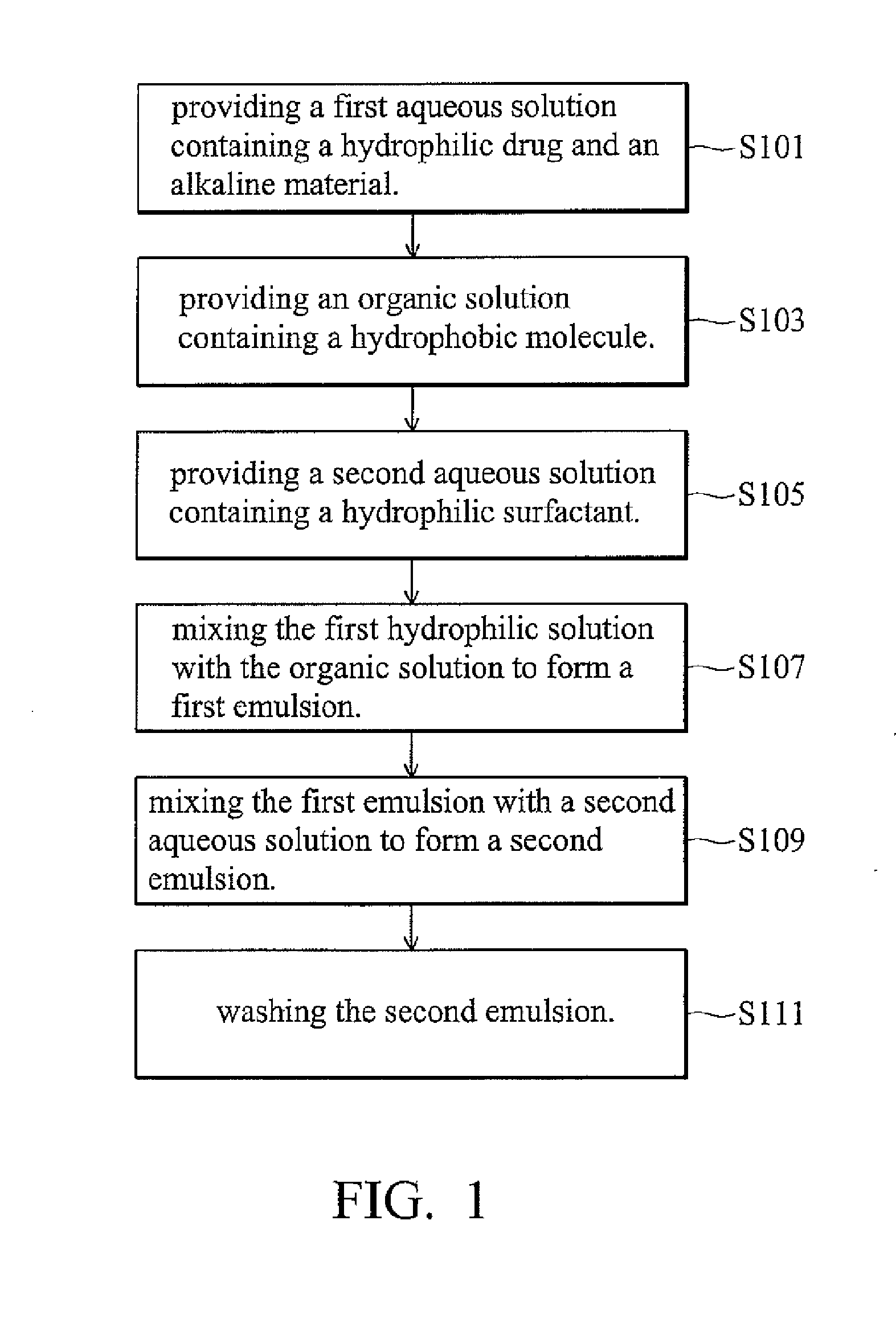Controlled release system and manufacturing method thereof
a technology of controlled release and release system, which is applied in the direction of pharmaceutical delivery mechanism, powder delivery, peptide/protein ingredients, etc., can solve the problems of low loading efficiency of water-soluble protein drugs, easy loss of activity of protein drugs without protection, and difficulty in dispersing solid-form complexes into the first emulsion, etc., to achieve slow release rate and stable ph value
- Summary
- Abstract
- Description
- Claims
- Application Information
AI Technical Summary
Benefits of technology
Problems solved by technology
Method used
Image
Examples
example 1
0% (span83)-0.1% (PVA)-10% (PLAG(65 / 35))-0 mg(HAP)
[0055]25 mg of bovine serum albumin (BSA) or 1 mg of fluorescein isothiocyanate-conjugated bovine serum albumin (FITC-BSA) and 250 μl of PBS were stirred for 5 min by oscillator to form a BSA / PBS solution (or FITC-BSA / PBS). The 0.25 g of PLGA dissolved in the 2.5 ml of dichloromethane to form a 10% PLGA solution. The BSA / PBS solution and PLGA solution were mixed at 1000 rpm for 15 min to form a first emulsion (w / o). The first emulsion (w / o) is added to 10 ml of 0.1% (w / v) PVA solution at 500 rpm for 5 min to form a second emulsion (w / o / w). After stirring for 4 hours and standing for 2 min, the supernatant of the second emulsion was obtained, and then centrifuged at 3000 rpm for 5 min to obtain a subphase solution. The subphase solution was again washed with ddH2O and centrifuged two times. The total subphase solutions were collected and free-dried to form the controlled release system of the invention. In this example, the rate of BS...
example 2
0% (span83)-0.1% (PVA)-10% (PLAG(65 / 35))-3.4 mg(HAp)
[0056]The same procedure carried out in Example 1 was repeated except that 3.4 mg of calcium phosphate tribase (HAp) was added. 1 g of the HAp (Alfa Aesar, AJahnson Matthey Company) was added to 10 ml PBS and mixed by supersonic oscillator for 10 min. After standing for 5 min, 250 μl of the supernatant (about 3.4 mg HAp) and 25 mg of BSA (or 1 mg of FITC-BSA) were mixed for 5 min to form BSA / HAp / PBS solution (or FITC-BSA / HAp / PBS). 0.25 g of PLGA were dissolved in 2.5 ml of dichloromethane to form a 10% PLGA solution. The BSA / PBS solution and PLGA solution were mixed with 1000 rpm for 15 min to form a first emulsion (w / o). The first emulsion (w / o) was added to 10 ml of 0.1% (w / v) PVA solution at 500 rpm for 5 min to form a second emulsion (w / o / w). After stirring for 4 hours and standing for 2 min, the supernatant of the second emulsion was centrifuged with 3000 rpm for 5 min to obtain a subphase solution. The subphase solution was a...
example 3
2% (span83)-0.1% (PVA)-10% (PLAG(65 / 35))-0 mg(HAp)
[0057]The same procedure carried out in Example 1 was repeated except that a 2% Span 83 hydrophobic surfactant was added to the 10% PLGA solution. In this example, the BSA encapsulation rate of the second emulsion was 97 to 99%, and the FITC-BSA encapsulation rate was 98 to 99%. Referring to FIG. 5a-5b, the second emulsion had a diameter below 50 μm. FIG. 5a is a SEM image of 200X magnification, and the FIG. 5b is a SEM image of 1000X magnification. FIG. 6a-6b show the fluorescence microscopy images obtained at 200X magnification (FIG. 6a), and 1000X magnification (FIG. 6b).
PUM
| Property | Measurement | Unit |
|---|---|---|
| temperature | aaaaa | aaaaa |
| diameter | aaaaa | aaaaa |
| diameter | aaaaa | aaaaa |
Abstract
Description
Claims
Application Information
 Login to View More
Login to View More - R&D
- Intellectual Property
- Life Sciences
- Materials
- Tech Scout
- Unparalleled Data Quality
- Higher Quality Content
- 60% Fewer Hallucinations
Browse by: Latest US Patents, China's latest patents, Technical Efficacy Thesaurus, Application Domain, Technology Topic, Popular Technical Reports.
© 2025 PatSnap. All rights reserved.Legal|Privacy policy|Modern Slavery Act Transparency Statement|Sitemap|About US| Contact US: help@patsnap.com



